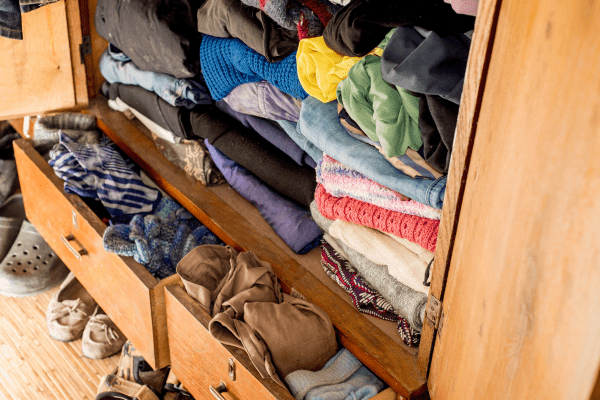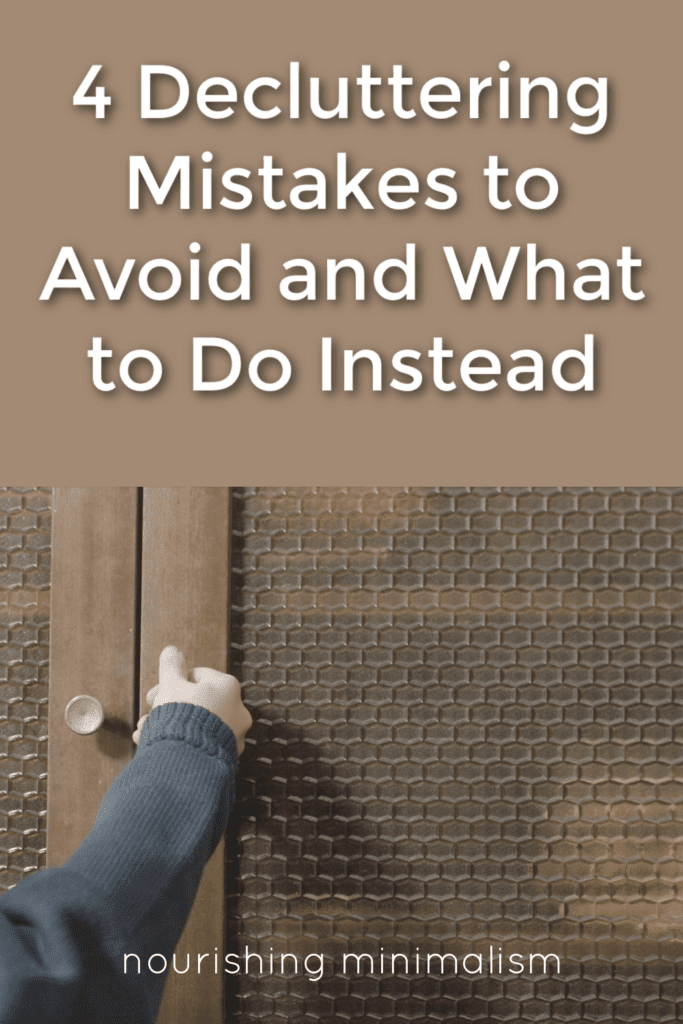4 Decluttering Mistakes to Avoid and What to Do Instead

Maintaining an organized and clutter-free home can feel like a never-ending battle. The constant influx of papers, clothes, and miscellaneous items can quickly turn our living spaces into chaotic zones.
However, decluttering doesn’t have to be an overwhelming task if we avoid some common mistakes and adopt effective strategies. In this blog post, we’ll delve into four decluttering mistakes to steer clear of and provide practical solutions to help us achieve a tidier and more serene living environment.
Mistake #1: Tackling Everything at Once
It’s tempting to dive headfirst into decluttering, trying to tackle the entire house in a weekend. But trust me, this approach leads to a crash and burn.
It’s so bad for us and our homes because we exhaust ourselves that weekend and then have no desire to clean or tidy anything for months afterward.
What to Do Instead:
Start your decluttering process by selecting a small area, such as a single drawer or shelf.
Set a specific time limit for yourself, like 15 to 30 minutes, and dedicate this period solely to decluttering.
Over time, this approach fosters consistency; change follows when we’re consistent with something.
Mistake #2: Emotional Attachment to Items
Stuff is just stuff, right?
I envy the people who have no attachment to their things! Wouldn’t it be nice to be able to sort through things and discard them without thinking twice??
Instead, I consider every item, feel all the feelings that come up, often just anxiety, and then make a decision on what to do with the item. It’s a full-on process.
What to Do Instead:
While keeping sentimental items is fine, it’s helpful to establish guidelines for what to keep and let go.
My favorite way to deal with actual sentimental items is the container method. Dana K White has an excellent video on it here.
What about the items that aren’t actually sentimental, but I have feelings for them??
When I think of “sentimental items,” I tend to think of Grandma’s tea cups and my daughter’s baby clothes.
But let’s shift that to “emotional attachment” instead. Then it opens up all sorts of things:
- The hot pads the kids got me for Christmas that are too thin to be helpful.
- The book my friend gave me, but I’ve never gotten past the first three pages.
- The piano bench that game from the church I grew up in.
- The curtains that were hanging in the house when we bought it.
- The scarf I’ve worn for the last five years but recently decided to replace it.
None of those items are things I would want to keep in my sentimental or memory box, but I have a strong emotional attachment to them, to the extent that if I think about getting rid of them, my chest tightens up, and I’m concerned that I will miss them.
Generally, we can be our own therapists as we work through these items.
Think through the first example: The kids wanted to get Mom a Christmas present, so they picked out some cute little hot pads. It was a nice thought, and the purpose was already fulfilled: they wanted to show Mom that they cared and were proud they picked something out. The sentiment was the important part.
And if I have to choose between these hot pads or the Mother’s day card where they wrote “You are the best mom I’ve ever had,” I’d rather keep the mother’s Day card.
Mistake #3: Lack of Regular Maintenance
Decluttering is a continuous process. It’s not a once-and-done ordeal; it takes effort on a regular basis.
Cleaning is the same way. Sure, it would be nice to clean the kitchen counters and not ever have to do it again – but the reality is, if we want a tidy house, we have to work at it every day.
This doesn’t mean we have to spend hours on it; it just means we have to have regular maintenance.
What to Do Instead:
- Enforce the “One in, one out” rule: whenever you add something new, remove an equivalent item. This prevents clutter buildup.
- Establish a consistent decluttering routine by dedicating weekly or monthly sessions. This proactive approach curbs clutter before it overwhelms you.
I feel I am in “maintenance mode” of minimalism, which means I’m comfortable with the amount of stuff we have. And on the weekend, when we do our weekly cleaning routine, I look for things that need to be decluttered – broken things, items that have been sitting on the hutch for too long, etc.
The “One in, one out” principle encourages mindful consumption, making each addition intentional.
Regular decluttering maintains an organized living space and prevents accumulation. Embracing both strategies creates a harmonious and clutter-free environment.
Mistake #4: Waiting for Perfect
Are you a perfectionist?
This can take on many different forms – Oh I’m waiting for the kids to grow out of the “toy” phase, or I’m waiting until I can take a week off work and FOCUS.
But waiting for the perfect time or until you can do it perfectly… it’s just another way to procrastinate.
What to Do Instead:
Look around the room right now and find something. ANYTHING you can declutter. This can be a receipt, a coupon, a broken mug, no matter how small it is – pick it up, make a decision to declutter it and throw it away or put it in a bag for a donation site.
There.
You started.
You’re welcome.
😘
Now that you’ve started make a commitment to declutter more. Set it on your schedule, and treat it like it’s important as if you have a doctor appointment that is vital to your wellbeing.
Because this is that important.
Perfect doesn’t exist. And decluttering is going to be hard work.
But it’s so worth it.
For some people, it’s easiest to commit to 5 items a day.
For others, they need to commit to 15 minutes each day.
And for others still, it’s easier to commit to one drawer or box each day.
Experiment and see which one motivates you the most.
If you need a more specific place to start, read this article.

